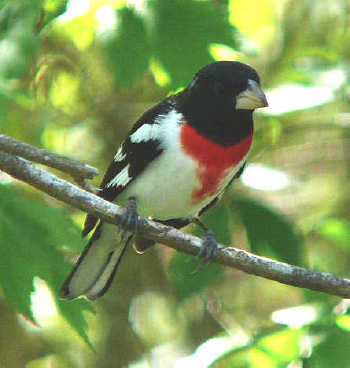
La página que intenta visitar sólo está disponible en inglés. ¡Disculpa!
The page you are about to visit is currently only available in English. Sorry!

The rose-breasted grosbeaks dropped in at Seasons, our retreat in the Taconic Hills on the New York-Connecticut line, on Sunday morning May 4th, right on schedule. They arrived just ahead of an overdue front of warm spring weather that kicked daytime temperatures from the cold 40’s into the sunny 70’s. Like magic, four ravenous males and a single female suddenly appeared at our feeders. Their migration from wintering to breeding areas had begun in Central America or perhaps Colombia or Ecuador with a stopover in the South. Rose-breasted grosbeaks are birds of deciduous forests east of the Great Plains, and this greening area could have been their final destination. We always have a nesting pair in our postage-stamp woodlot. On the other hand, our feeding station--offering sunflower seeds, shelled peanuts and nutty suet blocks—might have been a familiar place for the squadron to refuel before a final hop into New England or southern Quebec.
History doesn’t credit the French explorer who coined the name grosbec after encountering the evening grosbeak in the coniferous northern forests. The name is shared by five chunky woodland songbirds whose gross beaks are perfect for such chores as crushing cones, seeds and hard-bodied insects or nipping buds and bundles of tender pine needles. For example, beetles, grasshoppers, caterpillars and true bugs make up half the diet of the rose-breasted grosbeak, but in late summer and fall its colossal white appendage is usually stained purple with wild berry juice.

|
In my book, the rose-breasted grosbeak, with its sharp black-and-white plumage and deep-pink breast, is the most stunningly dressed of our Neotropical migrants. Of all the stored memories from a lifetime of watching birds, none is more than indelible than seeing five awesome males on a Droll Yankee tube feeder at one time! Long before there were field guides, Appalachian settlers called this species the “rosebird.” However, this songster is heard more often than seen as it flits through the forest penthouse, whistling a tune that Kenn Kaufman, author of the indispensable book Lives of North American Birds, perfectly describes as “an improved version of the American robin’s voice.”
If inspired, a rose-breasted grosbeak may sing all night. This from the journal of John James Audubon, who was camped along the Mohawk River in the then-wilds of New York: “I closed my eyes, and was passing away into the world of dream existence, when suddenly there burst on my soul that serenade of the Rose-breasted bird, so rich, so mellow, so loud in the stillness of the night that sleep fled my eyelids…One might easily have imagined that the Owl, charmed by such delightful music, remained reverently silent.”
Rose-breasted grosbeaks build nests that are so loosely constructed that it is sometimes possible to count the eggs from below. The parent birds share incubation and feeding chores, and the male will care for the fledlings while the female starts a second nest. In fact, she is so possessive of a good mate that other females vying for his attention will be driven away. Believe me, that gross beak is a formidable weapon. In my youth, when I was an apprentice bird-bander for the U.S. Fish and Wildlife Service, I made the mistake of not wearing gloves when facing a cage trap full of pugnacious evening grosbeaks. I have a scar on my thumb to remind me.